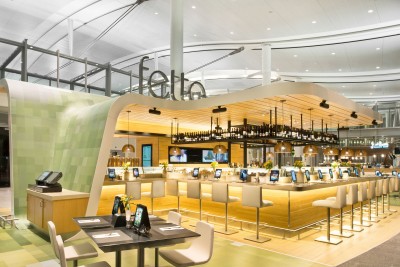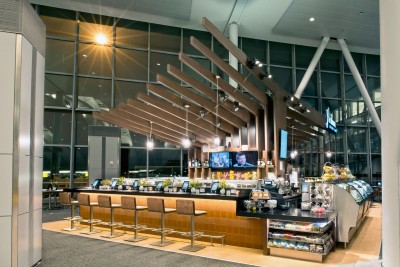Drive-thru boards
The combination of menu boards and promotional displays also applies to drive-thrus. In some cases, both types of display are incorporated into one monument sign.
Installing liquid crystal displays (LCDs) outdoors can be challenging, however, due to weather—e.g. direct sunlight, temperature fluctuations, humidity, wind and precipitation—and other hazards like vandalism. It is important to choose systems with suitable display capabilities in outdoor ambient lighting conditions and house them in durable enclosures.
“Lockout controls, refresh/wash capabilities to correct image retention, the warranty period and the ease of installation and replacement are equally important as how the display looks,” says Bruno Pupo, senior national sales manager for display vendor LG Electronics Canada.
Notification boards
There is also an opportunity in restaurants to use digital signage to display queuing information, order confirmations and pickup notifications.
Customers waiting to be seated on a busy night, for example, may worry whether or not they will hear their names called out by staff. Digital signage can provide a clearer, visual representation of this alert. And while customers are waiting, the same display can offer infotainment, suggest menu choices, introduce new products and announce upcoming events.
At the cashier counter, meanwhile, order confirmations can be displayed on a smaller-format screen as a natural extension of the restaurant’s point-of-sale (POS) system. And by connecting to the order entry database, suitable add-on menu items can be promoted on the same screen for upselling purposes.
For takeout services, pickup notifications can be integrated into promotional boards’ on-screen content. This is a good chance to encourage repeat visits in the future.
Table tablets
Another trend has been the deployment of tablet computers at restaurants’ tables, where they allow customers to browse through various drink and food menus and even place their orders.
This is the case for new restaurants in Terminal 1 of Toronto Pearson International Airport, for example, where guests have free access to Apple iPads at each seat. Digital menus are available through the devices in 12 languages and customers can even check their flight status while they dine.
Kiosks
Much as interactive kiosks have improved convenience at banks, airport flight desks and hotels, there is strong potential for their deployment in QSRs. They can reduce the incidence of incorrect orders and decrease perceived waiting times.
And much like how kiosks in cinemas promote popcorn while customers are buying their movie tickets, there is an opportunity for upselling. Jonpaul Leskie, who has deployed kiosks at two of his Hardee’s restaurants, says the average order increases by 18 per cent when made at a kiosk instead of at the counter.
Simple signage
Through these and other formats, the medium of digital signage is helping restaurants increase revenues. Not only have the costs of dynamic displays steadily declined in recent years, but they can also reduce a restaurant’s expenses in terms of the publishing, distribution, posting and disposal of static signage. Even the most simplistic uses of digital signage are offering benefits in terms of customer engagement and new revenue.
“Consumers’ actions are impacted by digital signage,” says Stratacahe’s Riegel. “A high-quality motion graphic of a premium product at the point of selection entices the customer to select it versus another product.”
Lyle Bunn, principal and strategy architect for Bunn, is an independent digital signage analyst, advisor and educator. This article is based on his guidebook to dynamic signage in food services. For more information, visit www.lylebunn.com.







